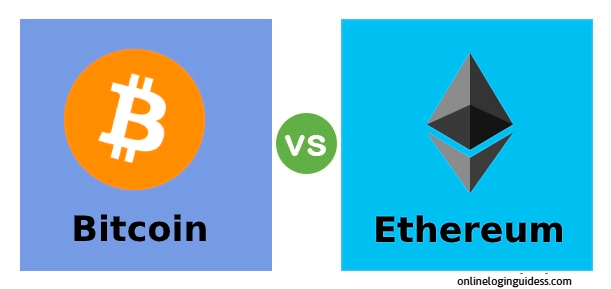How Bitcoin Mining Works: A Deep Dive Into the Process
Bitcoin, the world’s first decentralized cryptocurrency, relies on a unique mechanism called mining to verify and secure transactions on

Bitcoin, the world’s first decentralized cryptocurrency, relies on a unique mechanism called mining to verify and secure transactions on its blockchain network. Unlike traditional currencies, Bitcoin operates on a peer-to-peer network, and its creation and transaction verification involve an intricate process that requires computing power, energy, and sophisticated cryptographic protocols.
In this article, we’ll explore the key aspects of Bitcoin mining, from how it works to the impact it has on the global economy and the environment.
What is Bitcoin Mining?
At its core, Bitcoin mining is the process through which new bitcoins are created and transactions are added to the Bitcoin blockchain. This process is essential to ensure the security and integrity of the Bitcoin network. Miners use specialized hardware to solve complex mathematical problems, which in turn helps validate transactions and create new blocks on the blockchain.
Bitcoin mining serves two main purposes:
- Transaction Verification: Miners confirm transactions made by Bitcoin users, ensuring that there is no double-spending or fraud.
- Creation of New Bitcoins: As a reward for validating transactions, miners are compensated with newly minted bitcoins.
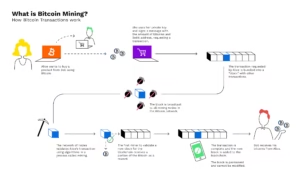
The Mining Process: A Step-by-Step Breakdown
1. Transaction Pool (Mempool)
When users send Bitcoin to one another, their transactions are temporarily stored in a waiting area known as the mempool. Transactions in the mempool are not yet confirmed and are awaiting validation by miners.
2. Block Formation
Miners collect unconfirmed transactions from the mempool and bundle them into a new block. Each block contains several transactions along with some metadata, including:
- The hash of the previous block (creating the chain of blocks).
- The timestamp of the block.
- A nonce (a random number used in the mining process).
3. Proof of Work (PoW)
To add a new block to the blockchain, miners must solve a complex cryptographic puzzle known as the Proof of Work (PoW). The PoW process involves finding a nonce that results in the hash of the block meeting certain criteria (usually a specific number of leading zeros in the hash).
Miners use powerful computers (known as ASICs or Application-Specific Integrated Circuits) to attempt billions of hash calculations per second in search of a solution. The first miner to find the correct nonce gets to add the new block to the blockchain and is rewarded with newly minted bitcoins.
4. Block Validation
Once the correct hash is found, the miner broadcasts the new block to the network. Other nodes (computers on the network) validate the block by checking that the transactions are legitimate and that the Proof of Work is valid.
If the block is validated, it is added to the blockchain, and the miner receives a reward in the form of new bitcoins. As of 2025, this reward is 6.25 bitcoins per block (though this amount halves approximately every 4 years in an event called Bitcoin halving).
5. Consensus and Security
The decentralized nature of Bitcoin’s network ensures that no single entity controls the blockchain. Each miner’s solution to the PoW puzzle serves as proof of their work, and the network reaches a consensus on the state of the blockchain. This makes it nearly impossible for any malicious actor to alter past transactions or reverse them, ensuring the network’s integrity and security.
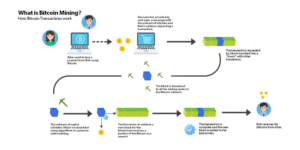
Bitcoin Mining Hardware
Bitcoin mining requires specialized hardware due to the increasing difficulty of the cryptographic puzzles miners must solve. In the early days of Bitcoin, it was possible to mine using regular personal computers (CPUs) or even graphics cards (GPUs). However, as more miners joined the network, the difficulty of mining increased, making these methods obsolete.
Today, most Bitcoin mining is done using ASIC miners, which are custom-built machines designed to perform the specific calculations needed for Bitcoin mining. ASIC miners are significantly more efficient than traditional computers and GPUs, and they can perform trillions of calculations per second.
Some of the most popular ASIC miners in the market today include:
- Bitmain Antminer S19 Pro
- MicroBT WhatsMiner M30S
- Canaan AvalonMiner 1246
These machines are housed in mining farms—large facilities that house hundreds or even thousands of mining rigs working simultaneously to secure the network and generate bitcoins.
Bitcoin Mining Difficulty and Halving
As more miners compete to mine Bitcoin, the difficulty of the Proof of Work puzzle increases to ensure that blocks are produced at a steady rate—approximately every 10 minutes. This difficulty adjustment is an automatic process that occurs every 2,016 blocks (roughly every two weeks).
The process of Bitcoin halving also impacts mining profitability. Every four years, the reward for mining a block is cut in half. When Bitcoin was first launched in 2009, miners earned 50 BTC per block. The current reward is 6.25 BTC, and after the next halving in 2028, it will drop to 3.125 BTC. This event is designed to control the supply of Bitcoin and prevent inflation.
The Environmental Impact of Bitcoin Mining
Bitcoin mining is energy-intensive, and this has raised concerns about its environmental impact. Mining operations require vast amounts of electricity, especially in areas where miners use cheap energy to maximize their profitability. According to some estimates, Bitcoin mining consumes more electricity than entire countries like Argentina.
To address these concerns, some mining operations are shifting towards renewable energy sources such as hydroelectric, solar, and wind power. Additionally, some countries are offering incentives to miners who use sustainable energy to reduce their carbon footprint.
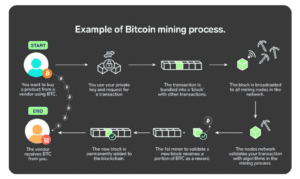
Is Bitcoin Mining Profitable?
The profitability of Bitcoin mining is influenced by various factors, including:
- Mining hardware efficiency: More efficient miners solve puzzles faster and use less electricity.
- Bitcoin price: A higher price means higher rewards for miners.
- Mining difficulty: As difficulty increases, miners must invest in better hardware and more energy.
- Electricity costs: Mining can only be profitable if electricity costs are low enough to outweigh operational expenses.
For individual miners, profitability can be challenging, especially with high competition and electricity costs. Many miners now join mining pools—groups of miners who combine their computational power to solve blocks and share the rewards. This allows miners to receive more consistent payouts, though the rewards are split among all participants.
The Future of Bitcoin Mining
The future of Bitcoin mining is filled with both challenges and opportunities. On one hand, the increasing difficulty and the environmental concerns around energy consumption may pose barriers to entry for new miners. On the other hand, technological advancements in mining hardware, the potential shift to renewable energy, and the continued global adoption of Bitcoin could lead to a more sustainable and efficient mining ecosystem.
With the upcoming Bitcoin halving events, miners will also need to adapt to a gradually reducing block reward. This will likely drive further innovation in mining technologies and strategies as miners strive to maintain profitability.
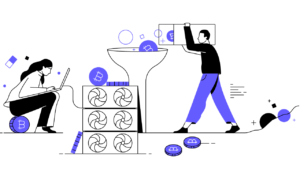
Conclusion
Bitcoin mining is the backbone of the Bitcoin network, playing a crucial role in transaction validation, network security, and the creation of new bitcoins. While mining can be complex and resource-intensive, it remains one of the most important processes in the world of cryptocurrency. Understanding the inner workings of Bitcoin mining not only provides insight into how cryptocurrencies function but also sheds light on the ongoing technological and economic challenges in this rapidly evolving field.












